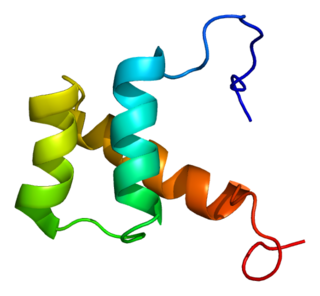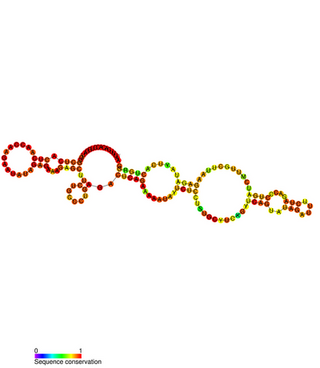Homeobox protein DLX-5 is a protein that in humans is encoded by the distal-less homeobox 5 gene, or DLX5 gene. [5] [6] DLX5 is a member of the DLX gene family.
Homeobox protein DLX-5 is a protein that in humans is encoded by the distal-less homeobox 5 gene, or DLX5 gene. [5] [6] DLX5 is a member of the DLX gene family.
This gene encodes a member of a homeobox transcription factor gene family similar to the Drosophila distal-less (Dll) gene. The encoded protein may play a role in bone development and fracture healing. Current research holds that the homeobox gene family is important in appendage development. DLX5 and DLX6 can be seen to work in conjunction and are both necessary for proper craniofacial, axial, and appendicular skeleton development. Mutations in this gene, which is located in a tail-to-tail configuration with DLX6 on the long arm of chromosome 7, may be associated with split-hand/split-foot malformation. [6]
DLX5 also acts as the early BMP-responsive transcriptional activator needed for osteoblast differentiation by stimulating the up-regulation of a variety of promoters (ALPL promoter, SP7 promoter, MYC promoter). [7]
Mutations in the DLX5 gene have been shown to be involved in the split hand and foot malformation syndrome (SHFM). [8] SHFM is a heterogenous limb defect in which the development of the central digital rays is hindered, leading to missing central digits and claw-like distal extremities. Other defects associated with DLX5 include sensorineural hearing loss, mental retardation, ectodermal and craniofacial findings, and orofacial clefting.
In mice, the targeted disruption of DLX1, DLX2, DLX1/2, or DLX5 orthologs yields craniofacial, bone, and vestibular defects. If DLX5 is disrupted in conjunction with DLX6, bone, inner ear, and severe craniofacial defects are prevalent. Research utilizing Dlx5/6-nulls suggests that these genes have both unique and redundant functions. [9]
DLX5 begins to express DLX5 protein in the facial and branchial arch mesenchyme, otic vesicles, and frontonasal ectoderm at around day 8.5-9. By day 12.5, DLX5 protein begins to be expressed in the brain, bones, and all remaining skeletal structures. Expression in the brain and skeleton begins to decrease by day 17. [7]
DLX5 has been shown to interact with DLX1, [9] DLX2, [10] DLX6, [9] MSX1 [10] and MSX2. [10]
Genes in the DLX family encode homeodomain transcription factors related to the Drosophiladistal-less(Dll) gene. The family has been related to a number of developmental features such as jaws and limbs. The family seems to be well preserved across species. As DLX/Dll are involved in limb development in most of the major phyla, including vertebrates, it has been suggested that Dll was involved in appendage growth in an early bilaterial ancestor.

HNF1 homeobox B, also known as HNF1B or transcription factor 2 (TCF2), is a human gene.

Pre-B-cell leukemia transcription factor 1 is a protein that in humans is encoded by the PBX1 gene. The homologous protein in Drosophila is known as extradenticle, and causes changes in embryonic development.

Homeobox protein MSX-1, is a protein that in humans is encoded by the MSX1 gene. MSX1 transcripts are not only found in thyrotrope-derived TSH cells, but also in the TtT97 thyrotropic tumor, which is a well differentiated hyperplastic tissue that produces both TSHß- and a-subunits and is responsive to thyroid hormone. MSX1 is also expressed in highly differentiated pituitary cells which until recently was thought to be expressed exclusively during embryogenesis. There is a highly conserved structural organization of the members of the MSX family of genes and their abundant expression at sites of inductive cell–cell interactions in the embryo suggest that they have a pivotal role during early development.

Homeobox protein Nkx-3.1, also known as NKX3-1, NKX3, BAPX2, NKX3A and NKX3.1 is a protein that in humans is encoded by the NKX3-1 gene located on chromosome 8p. NKX3-1 is a prostatic tumor suppressor gene.

Homeobox protein MSX-2 is a protein that in humans is encoded by the MSX2 gene.

PBX/Knotted 1 Homeobox 1 (PKNOX1) is a protein that in humans is encoded by the PKNOX1 gene.

Melanoma-associated antigen D1 is a protein that in humans is encoded by the MAGED1 gene.

Homeobox protein DLX-3 is a protein that in humans is encoded by the DLX3 gene.

Homeobox protein DLX-4 is a protein that in humans is encoded by the DLX4 gene.

Homeobox protein Hox-C4 is a protein that in humans is encoded by the HOXC4 gene.

Heart- and neural crest derivatives-expressed protein 2 is a protein that in humans is encoded by the HAND2 gene.

Homeobox protein DLX-2 is a protein that in humans is encoded by the DLX2 gene.

Transcription factor Sp7, also called osterix (Osx), is a protein that in humans is encoded by the SP7 gene. It is a member of the Sp family of zinc-finger transcription factors It is highly conserved among bone-forming vertebrate species It plays a major role, along with Runx2 and Dlx5 in driving the differentiation of mesenchymal precursor cells into osteoblasts and eventually osteocytes. Sp7 also plays a regulatory role by inhibiting chondrocyte differentiation maintaining the balance between differentiation of mesenchymal precursor cells into ossified bone or cartilage. Mutations of this gene have been associated with multiple dysfunctional bone phenotypes in vertebrates. During development, a mouse embryo model with Sp7 expression knocked out had no formation of bone tissue. Through the use of GWAS studies, the Sp7 locus in humans has been strongly associated with bone mass density. In addition there is significant genetic evidence for its role in diseases such as Osteogenesis imperfecta (OI).

ALX homeobox protein 1 is a protein that in humans is encoded by the ALX1 gene.

Homeobox protein DLX-1 is a protein that in humans is encoded by the DLX1 gene.

Homeobox protein DLX-6 is a protein that in humans is encoded by the DLX6 gene.

E3 ubiquitin-protein ligase Praja1 is an enzyme that in humans is encoded by the PJA1 gene.

E3 ubiquitin-protein ligase Praja2 is an enzyme that in humans is encoded by the PJA2 gene.

DLX6 antisense RNA 1 (DLX6-AS1) is a developmentally-regulated long non-coding RNA. In rats, it is expressed in neurons in the subventricular zone of the developing forebrain. Its expression is linked to that of the Shh and DLX families of genes, which are important in ventral forebrain and craniofacial development. An alternatively spliced form of DLX6-AS1, DLX6-AS2, forms a stable complex with the Dlx-2 protein. This complex activates transcription of Dlx-5 and Dlx-6.
This article incorporates text from the United States National Library of Medicine, which is in the public domain.